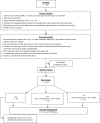Multicenter randomized trial of robot-assisted rehabilitation for chronic stroke: methods and entry characteristics for VA ROBOTICS
- PMID: 19541917
- PMCID: PMC5583723
- DOI: 10.1177/1545968309338195
Multicenter randomized trial of robot-assisted rehabilitation for chronic stroke: methods and entry characteristics for VA ROBOTICS
Abstract
Background: Chronic upper extremity impairment due to stroke has significant medical, psychosocial, and financial consequences, but few studies have examined the effectiveness of rehabilitation therapy during the chronic stroke period.
Objective: . To test the safety and efficacy of the MIT-Manus robotic device for chronic upper extremity impairment following stroke.
Methods: . The VA Cooperative Studies Program initiated a multicenter, randomized, controlled trial in November 2006 (VA ROBOTICS). Participants with upper extremity impairment >/=6 months poststroke were randomized to robot-assisted therapy (RT), intensive comparison therapy (ICT), or usual care (UC). RT and ICT consisted of three 1-hour treatment sessions per week for 12 weeks. The primary outcome was change in the Fugl-Meyer Assessment upper extremity motor function score at 12 weeks relative to baseline. Secondary outcomes included the Wolf Motor Function Test and the Stroke Impact Scale.
Results: . A total of 127 participants were randomized: 49 to RT, 50 to ICT, and 28 to UC. The majority of participants were male (96%), with a mean age of 65 years. The primary stroke type was ischemic (85%), and 58% of strokes occurred in the anterior circulation. Twenty percent of the participants reported a stroke in addition to their index stroke. The average time from the index stroke to enrollment was 56 months (range, 6 months to 24 years). The mean Fugl-Meyer score at entry was 18.9.
Conclusions: . VA ROBOTICS demonstrates the feasibility of conducting multicenter clinical trials to rigorously test new rehabilitative devices before their introduction to clinical practice. The results are expected in early 2010.
Figures
References
-
- Rosamond W, Flegal K, Furie K, et al. Heart disease and stroke statistics—2008 update: a report from the American Heart Association Statistics Committee and Stroke Statistics Subcommittee. Circulation. 2008;117:e25–e146. - PubMed
-
- Bard G, Hirschberg GG. Recovery of voluntary motion in upper extremity following hemiplegia. Arch Phys Med Rehabil. 1965;46:567–572. - PubMed
-
- Olsen TS. Arm and leg paresis as outcome predictors in stroke rehabilitation. Stroke. 1990;21:247–251. - PubMed
-
- Parker VM, Wade DT, Langton Hewer R. Loss of arm function after stroke: measurement, frequency, and recovery. Int Rehabil Med. 1986;8:69–73. - PubMed
Publication types
MeSH terms
Grants and funding
LinkOut - more resources
Full Text Sources
Medical


